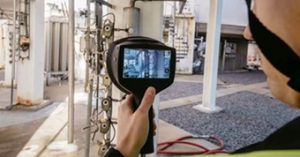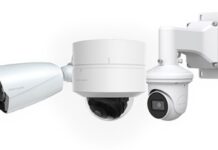
The Teledyne FLIR range of acoustic imaging cameras, the Si124, Si124-PD, and Si124-LD offer an improved bandwidth range for detecting compressed air leaks in industrial settings. The change means that the industry-leading range can detect leaks from anywhere between 2 to 65 kHz and adds crucial functionality to the previous peak bandwidth of 35 kHz.
While it may seem like a minor change, the operational impact of the improvements cannot be overstated: it means marked savings for industrial applications globally, reducing costs and improving reliability.
The range of three cutting-edge Si124 models is equipped to measure virtually all compressed air leaks in manufacturing settings regardless of how small and seemingly insignificant. This unique range covering 63 kHz is scientifically the optimal sound spectrum range for detecting leaks on this measurable threshold.
Detecting ranges outside of this spectrum detracts from long-term functionality as detecting background noise beyond 65 kHz can interfere with baseline readings and negatively impact leak detection.
Failure to detect air leaks can cost companies thousands of pounds in replacement costs for units that are not operating optimally and can have a knock-on effect on production when parts are replaced and production lines are forced into downtime.
Federico De Lucia, Team Lead of Condition Monitoring Specialists (EMEA Solutions) at Teledyne FLIR explains why this seemingly small change cements the Si124 range as operating across the optimum bandwidth for detecting compressed air leaks in industrial applications.
As well as benefiting from the optimum range of bandwidth for compressed air leak detection, the Si124 range also offers clear advantages for inspectors in industrial applications.
The Si124 range is incredibly lightweight. It is almost 60% lighter than rival models on the market at just 1.25kg including the battery. This makes sure that they can be used with a single hand, freeing up the operator to carry out harder-to-reach inspections in challenging environments.
The lightweight range can be used for up to two hours and can even be operated in a range of challenging industrial settings from between –10°C to 50°C (14°F to 122°F), making it one of the most robust models available.
The acoustic imaging camera range can detect problems up to 10 times faster than traditional methods, including detecting air leaks, minimising excess utility costs, and making avoidable equipment failures in pneumatic machinery a thing of the past.
The range also has an agile AI that uses projective algorithms to estimate how much a detected compressed air leak will cost by evaluating the air lost in real-time, calculating the spend per kWh, and displaying an expected saving per year. Critically, this ensures that inspectors have valuable evidence needed to justify any incurred repair costs across the production line.
The Si124 range also benefits from Thermal Studio: a FLIR-exclusive plug-in that can build reports with more than 100 images quickly with fully customisable templates, overlays, and formulas. It streamlines thermal imaging analysis and ensures that inspectors can analyse, edit, segment, and edit thermal video.











